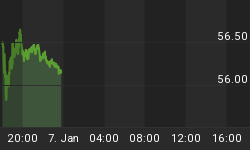Last week was fairly neutral, but there were some positive developments for the stock market.
Momentum indicators:
One of the best ways to determine that a trend is losing its momentum and is about to reverse, is by analyzing oscillators. Many different types of oscillators have been created, but they are pretty much analyzed in the same manner: a) the oscillator is either overbought or oversold, and b) the oscillator exhibits negative or positive divergence to the price trend.
Two widely used oscillators are the stochastics, which is primarily used as an OB/OS indicator, and the MACD which is more indicative of a momentum change in the market. Both are shown on the following daily chart of the SPX, courtesy of StockCharts.

You will note that the stochastics (at the top of the chart) has been oversold for a while now, and the MACD has flattened out and is trying to turn up. These readings indicate that the market is losing its downside momentum and may be ready for a short term rally. They are not particularly bullish. The MACD is showing very little positive divergence compared to prices.
Breadth indicators:
The McClellan oscillator has rebounded from a deeply oversold position to a slightly overbought reading. This is good action. When horrendous negative numbers were registered by the advance/decline and new highs/new lows statistics recently, it was suggested that this was more likely to be the result of climactic action and indicative of the end of a trend rather than the beginning of a new decline. It would now appear that this is indeed the case. Since that breadth climax, there have been about 4500 net positive advances and by Friday, the new highs/new lows were just about even. It is possible that this positive action was, in part, the result of options expiring.
Should the markets decline further, this will very probably set up positive divergence readings in these indicators and signal the end of a down trend..
Leading indicators:
It is helpful to compare the action of certain stocks and indexes which tend to lead the market, to the action of the S&P 500 and the Dow to see if they confirm that action or tell a different story.
GE and the QQQ have consistently appeared to give early warnings that the market trend is turning. During the most recent decline, both have refused to go below their lows of 3/24 while the Dow and the SPX made slightly new lows on 5/12.
The Dow Jones Transportation Index behaved similarly and refused to confirm the new lows registered by the Industrials.
But this is only half of the story. These "leading indicators" must extend their gains and remain above their lows if another short term decline materializes, especially if the major indices make new lows.
Structure:
Both the intermediate and short term patterns are ambiguous and will require more time to reveal themselves, but they continue to suggest that prices are merely consolidating their recent gains and do not indicate that there will be significant weakness directly ahead. The short term trend, when analyzed on the hourly chart, does not look complete and is making a somewhat bearish price pattern.
Fibonacci:
It has been mentioned previously that the 4th week in June will be the 233rd week from the top of the market in 2000, and the 89th week from the 4-yr low of October 2002. These are important numbers in the Fibonacci sequence, and previous dates associated with this sequence have tended to cause intermediate term reversals of prices. There are also other technical criteria which makes this an important time period to watch.
Coincidentally, June 30 is the date of the next the FOMC meeting, at which time it is expected that the Fed will announce a rate increase. It is also the date of the turning over of control of Iraq to the Iraqi.
SUMMARY:
Although the action of the market was mildly constructive this week, it merely indicates a dearth of selling and does not yet suggest an important reversal. The cyclic and technical positions of the stock market remains as follows:
VERY LONG TERM: Down until (CA) 2014. This is the anticipated date of the 40-year cycle low.
LONG TERM: Up since 10/02, the date of the upturn of 12-yr and 4-year cycles, and further reinforced by the 20-week cycle which bottomed in 3/03
INTERMEDIATE TERM: Down/sideways, caused by the topping of the 120-week cycle and the bottoming of the 10-year cycle which is due to make its low in the Fall of this year (ideally).
SHORT TERM: Down, attempting to reverse. Pattern does not yet look complete.
GOLD continues to follow the scenario outlined in the past few weeks. More base building will be required before a sustained rally can occur.
The DOLLAR has reached its projected 92 target and has began to pull back, although wave 5 of the move from the lows may not yet be complete.. The daily MACD is beginning to show negative divergence and suggests that a short term correction may be under way.















